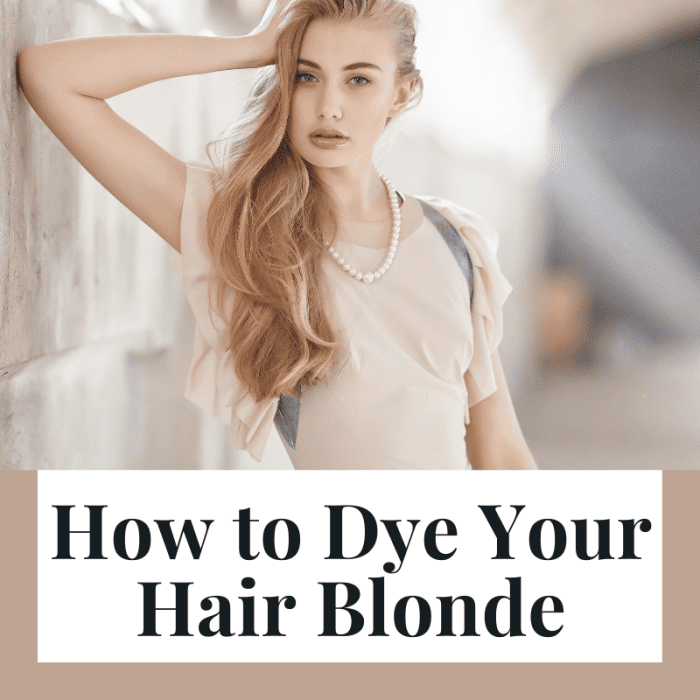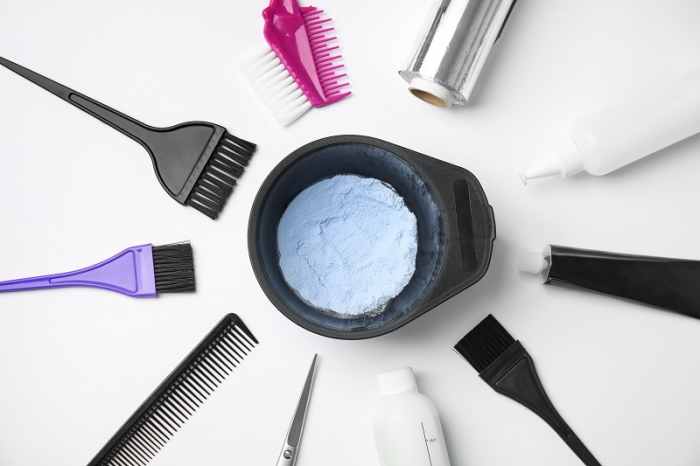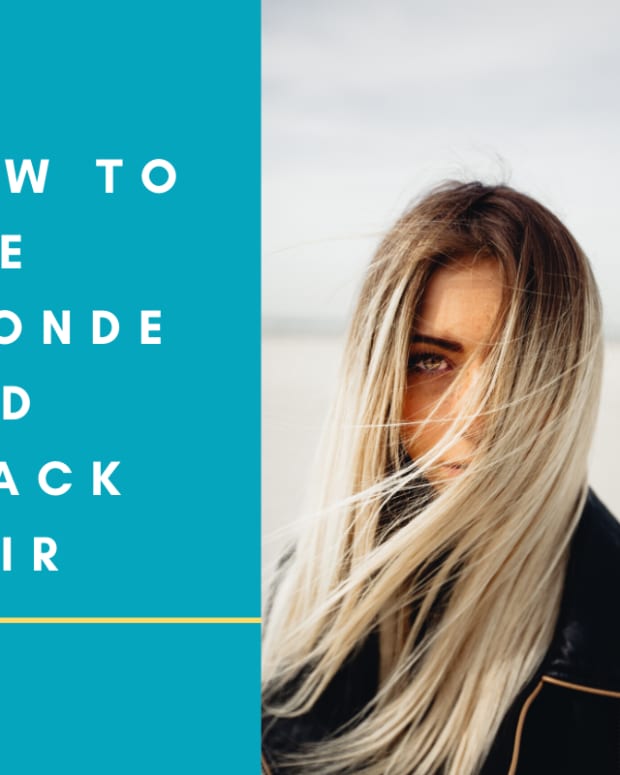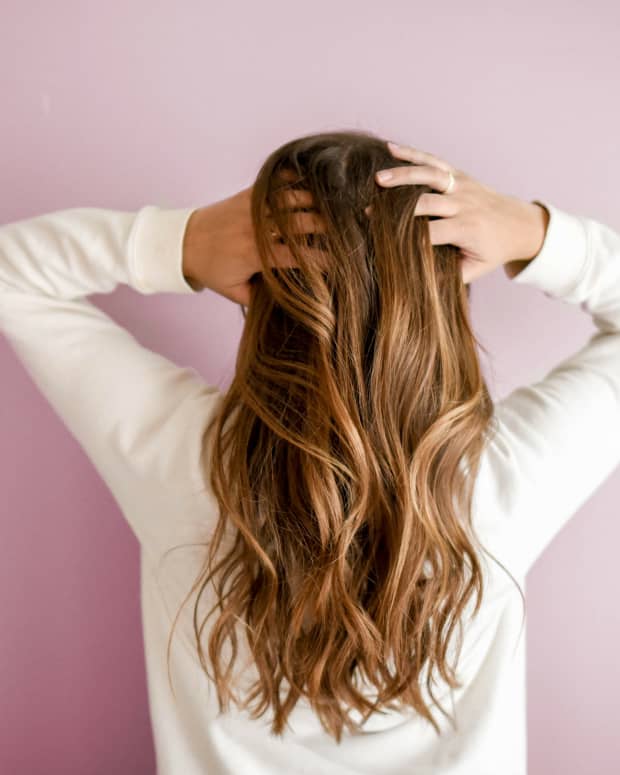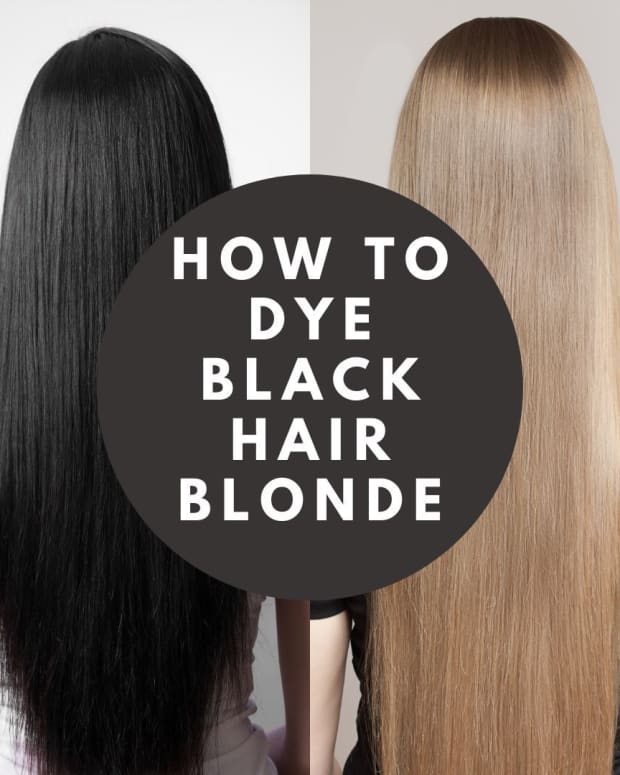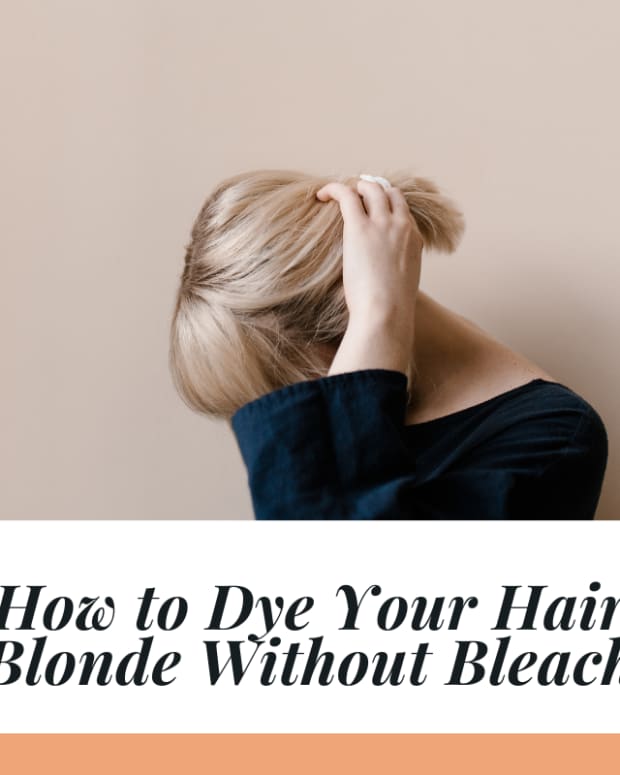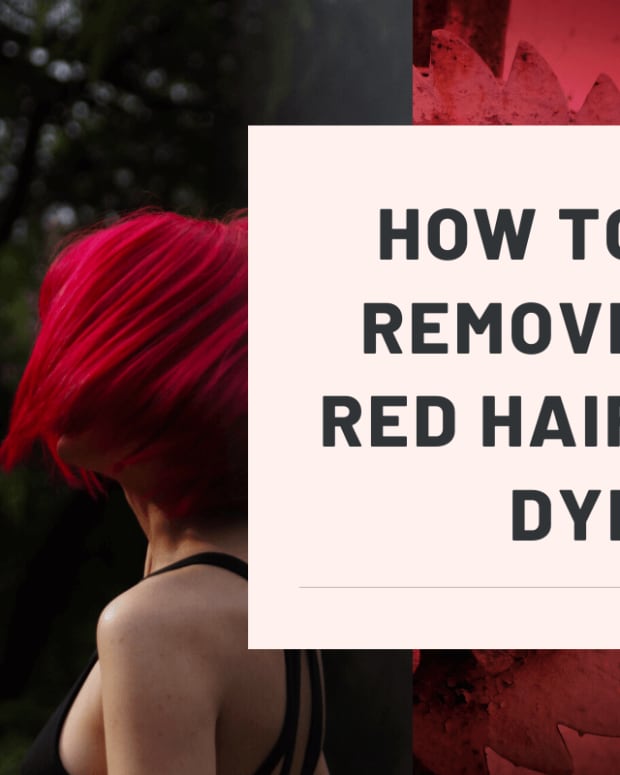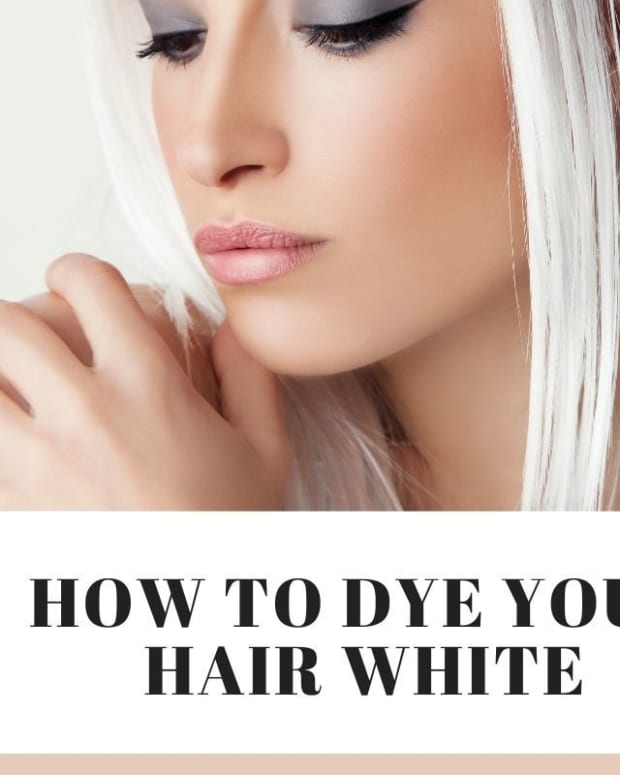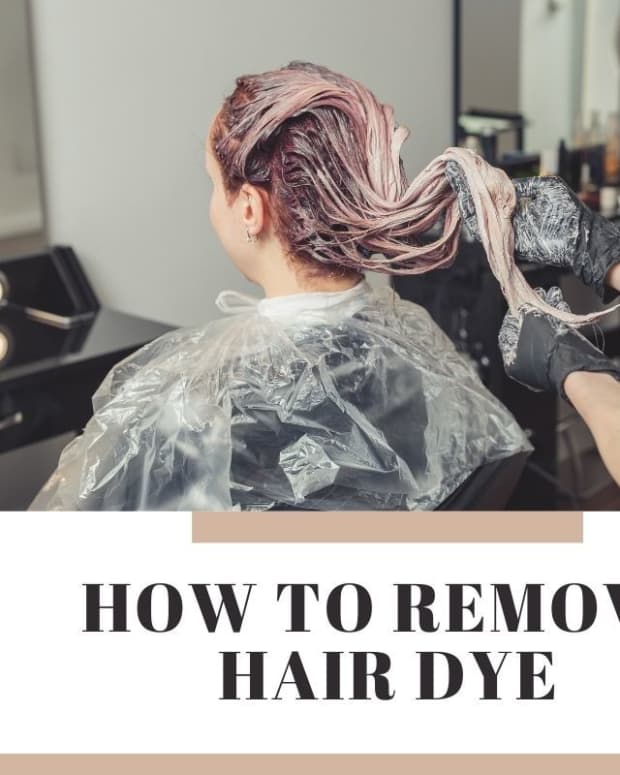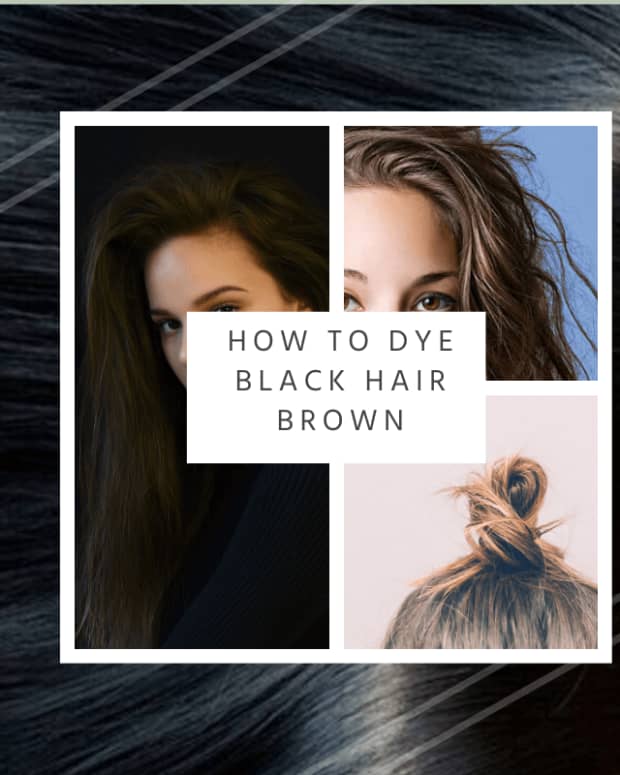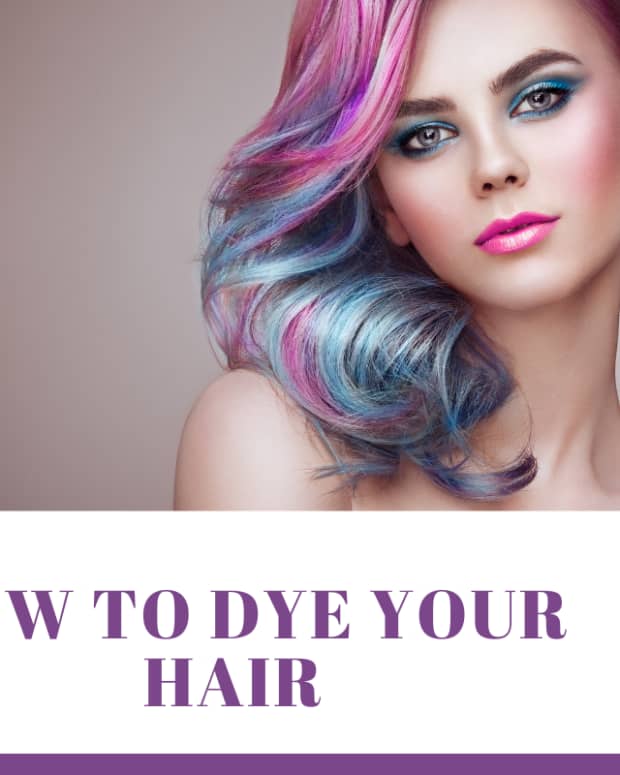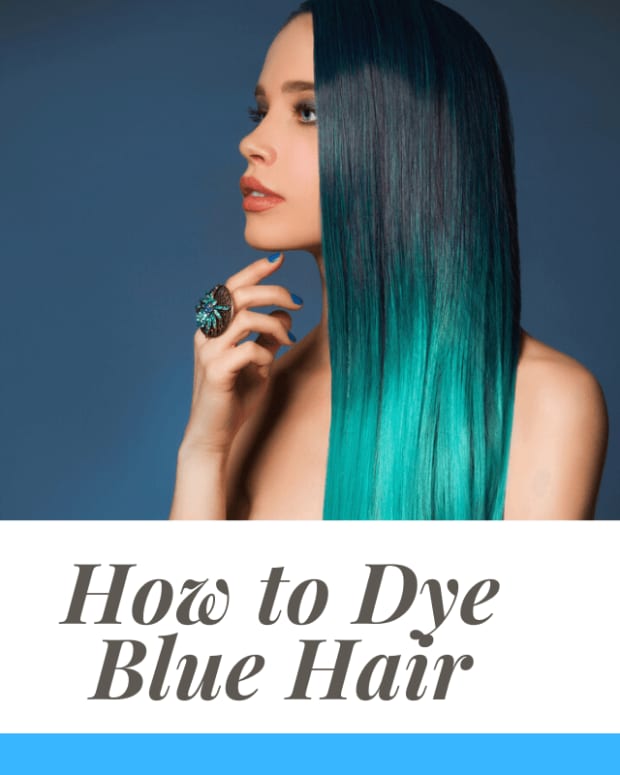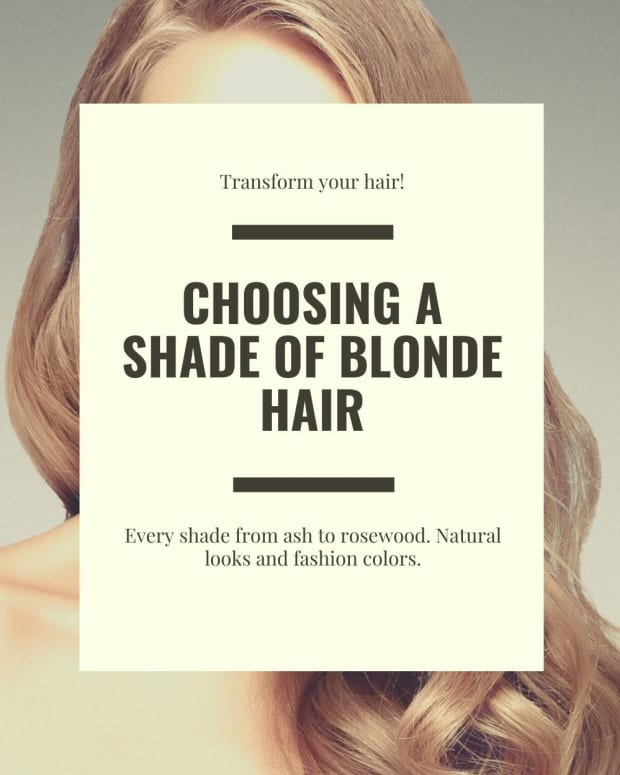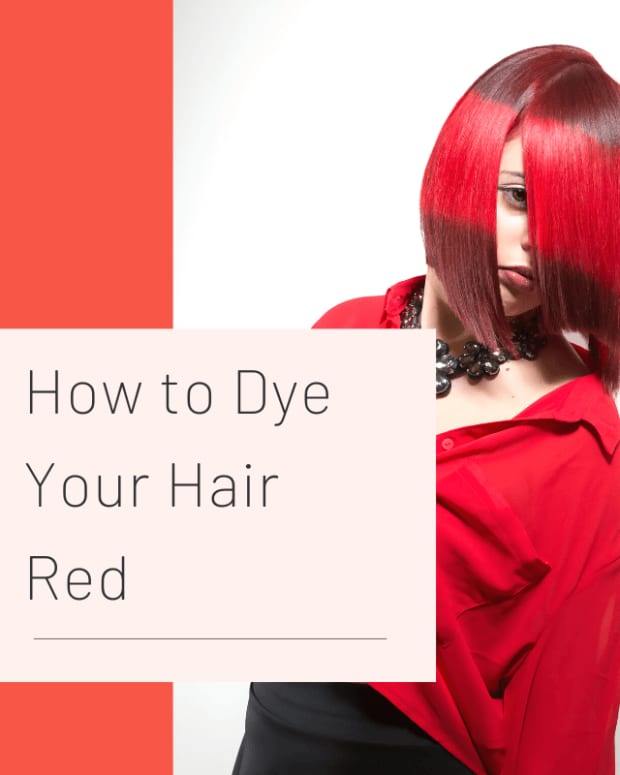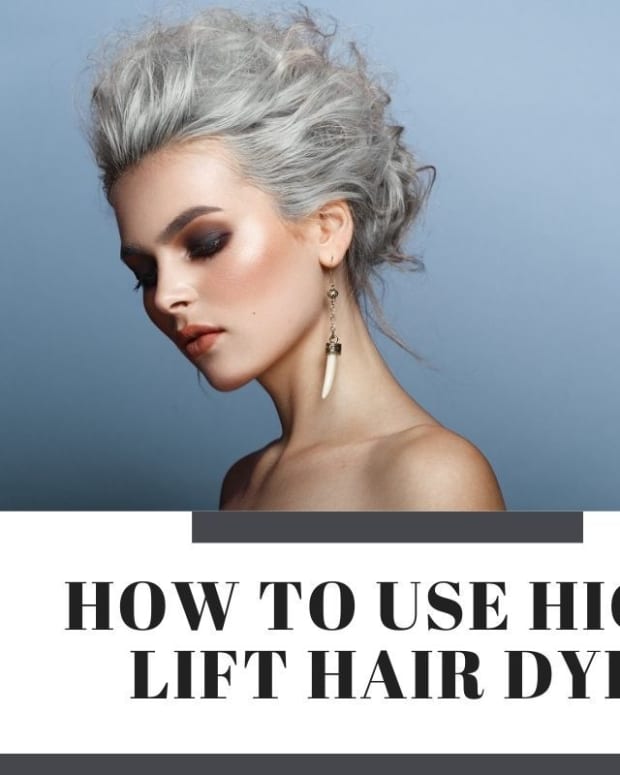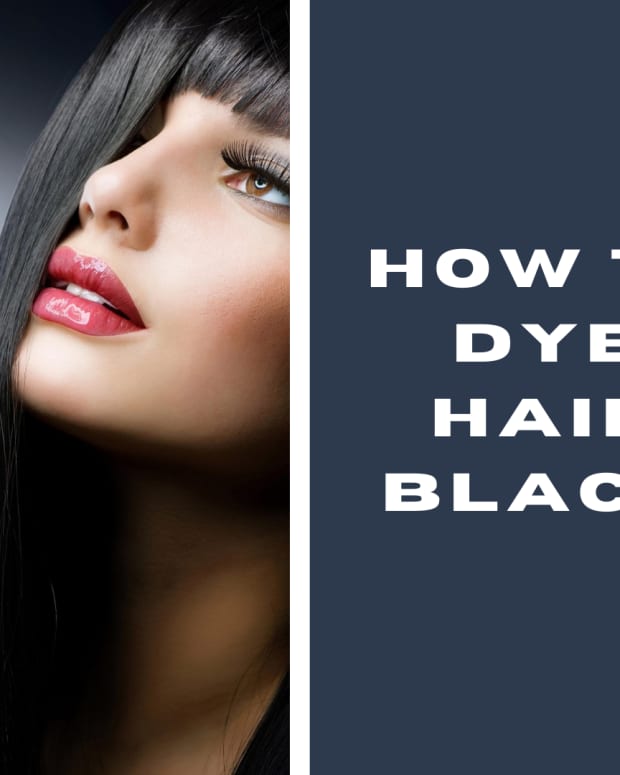How to Dye Hair Blonde
Maffew is a hairdresser, marketer, and dabbler in many things who enjoys sharing knowledge about the science of hair coloring and hair care.
Do you dream of dyeing your hair blonde? If your natural hair color is brunette or black, having lighter hair can be a nice change of pace. The distinctive contrast between your natural shade and a blonde color makes for an exciting transformation.
The actual process to achieve blonde hair is often thought to be difficult though as it can require the use of bleach and more than one coloring step. This article will cover everything you need to consider, from preparing to lighten your hair to the maintenance of the final result.
Products and Tools Required
Any change in hair color requires the right tools to get the job done and the process to dye hair blonde is no exception. For this task, you'll need all of these products, with the exception of bleach if your hair is already on the lighter side, but there will be a special note on that later.
- Quality bleach powder
- Developer
- Blonde dye or toner
- Tinting bowl and brush
- Sectioning clips
- Comb
- Gloves
Steps
To simplify the process of dyeing your hair blonde, you need to go through the following steps to plan the process and ensure that you fully understand everything that needs to be done:
- Assess Your Hair: You'll consider the current color, condition, and texture of your hair. This is necessary to decide on the best products to use and to keep your hair healthy during and after lightening.
- Choose the Right Shade of Blonde: The best shade for you is the one you like, but this section will also help you match colors to your features so that you know what shades will suit you the most.
- Lightening Your Hair: Whether you need to lighten your hair a little or a lot, this section will tell you everything you need to know to do it safely and effectively.
- Toning Your Hair: After lightening, you need to tone your hair to get a natural blonde result.
- Maintenance and Repair: Finally, this section will explain all the steps and tips needed for you to maintain your favorite shade and repair damaged hair. This will keep your new style looking great.
1. Assess Your Hair
Before you can dye your hair blonde, you need to assess the condition of your hair. Hair that is in poor condition due to frequent heat styling, previous dyes, or other chemical treatments is at greater risk of being damaged if you bleach it. It also may not look as good in the end, even if it still feels strong.
The texture of your hair, whether it's thick and coarse, or thin and fine is a strong indication of how much chemical processing it can handle before beginning to show visible signs of damage. If you have coarse hair, you can put it through more stress, but don't get too carried away.
Previously Dyed Hair
You will also need to approach the process in a different way, depending on what you've previously done to your hair and its current color. If you've dyed your hair black or darker shades of brown, you'll notice it has become much more resistant to lightening if you attempt to bleach it.
Previously dyed hair should ideally be stripped using dye remover first, and the decision of whether to dye your hair blonde should only occur after seeing how much of the dye was successfully removed. The product used to do this doesn't damage hair and is simple to use. For more instructions, see the color remover section of my article about removing black hair dye.
If you've dyed your hair multiple times with the same dark shade, the effectiveness of dye stripping falls significantly, and you will need to consider whether a visit to the salon would be better for your needs as a long process of dye removal and gentle bleaching will follow.
Natural Dark Hair
If you haven't dyed your hair previously and this is your natural color, you can dye your dark hair to blonde very reliably. Depending on how light you want it to be, you may need to bleach it twice though and you should wait at least a week between sessions to minimize damage.
Make sure to take this into consideration if your hair is fine or damaged from other sources like heat styling.
2. Choosing What Shade of Blonde to Dye Your Hair
Blonde hair comes in a diverse range of shades varying by how warm-toned or cool-toned they are, as well as the primary color present in the shade giving it its nuance. Some of the most common shades include:
- Natural Blonde
- Pearl Blonde
- Ash Blonde
- Beige Blonde
- Golden Blonde
- Strawberry Blonde
Read More From Bellatory
All of these shades can also range from platinum to dark blonde in depth. While you can dye your hair whichever shade you like the most, your blonde hair will look best if it matches the look of your skin and eyes so this is something to consider.
Typically, paler skin tones and eye colors match better to lighter and cooler-toned blonde hair. Darker or warm shades of blonde are better for skin that is tanned or darker, as well as hazel and brown eyes.
For more information about how to determine the tone of your skin, as well as more color recommendations, check out my related article for choosing the right shade of blonde.
3. Lightening Your Hair
Once you've decided whether you can dye your hair blonde, and the shade you prefer to achieve, you'll need to start with lightening your hair. It is possible to lighten your hair to blonde without bleach, but this depends on how dark your natural color is and how much lighter you want to take it.
When bleaching your hair, you'll end up with superior lightening and less damage if you use a high-quality professional brand of bleach powder. Cheaper generic brands don't contain the same lighteners as these products, nor do they typically contain the boosters that make it easier to dye dark hair blonde in one process.
For the best results, choose a quality brand like one of the following, or the best available to you:
Blue vs. White Bleach Powder
Whether you use a white- or blue-colored powder is completely up to you and doesn't really matter much in terms of results.
The intention of blue powder is to help tone the hair while it lightens, but this tone is temporary and can serve to cloud your judgment in choosing when to rinse out the bleach as your hair will look lighter and cooler-toned due to the blue pigment coating it.
With that said, it's more common for bleach to be blue by default if the brand you're using doesn't offer a choice, so choose whichever you prefer and don't worry too much about it.
Preparation
In order to apply the product, you'll require an assortment of sectioning clips and a good tail comb to part and section the hair, as well as a tinting bowl and brush for mixing and applying the bleach.
All hair dyes and bleaches should also be applied using gloves. Vinyl or nitrile gloves are the best types to use for this purpose. Latex can be used, but be aware it tends to cling to hair much more readily and this can not only potentially be painful, but also make the application more difficult.
Once you're ready to lighten your hair to blonde, separate it out into four quadrants by parting down the middle and then again from ear to ear.
Choosing a Developer
Before you can mix and apply bleach however, you need to choose the developer to prepare it with. Developer is a solution of hydrogen peroxide in varying strengths.
Bleach powder needs to be mixed with developer in order to start lightening the hair. This should be done in the ratio recommended for the particular brand you're using and could be 1:1, 1:2, or even 1:3 powder to developer ratio.
As developer varies in strength, measured in volume, the volume of developer you add will affect how strong the bleach is. For generic brands, use no higher than 30 vol. You can and should reduce this to 20 vol if your scalp is sensitive to the product.
When using a premium product, it will generally recommend no higher than 20 vol developer be added and this is because the bleach powder will contain boosters and more effective lightening ingredients. A higher developer used in these products is unnecessary and can cause extreme irritation in some people.
If you have very dark hair, use the highest volume of developer that the brand allows, and that your scalp can handle. However, don't take this so high that you feel pain during the process. Warmth and a mild itch or tingling feeling is normal but clearly-perceptible pain should not be tolerated and the product should be rinsed.
Application
The quicker you can apply bleach, the more even the result will be. You can achieve this by working with sections as mentioned earlier.
- When you're ready to begin applying the bleach, start at the back of your hair at one quadrant, using the brush to apply sufficient amounts of the product.
- Apply the bleach in thin sections of hair from the top to bottom of the quadrant, using the tail of the tinting brush to lift and part sections as you work.
- When you complete a quadrant, move to the other back quadrant and continue in the same fashion before repeating the same process on the front two quadrants.
- Work as quickly as you can whilst ensuring you don't miss any areas.
When you're done with the application, you have some time to rest and prepare for washing the bleach out. During this time you should check the bleach often while it's in your hair.
During the lightening process, it's important that you keep track of the amount of time that has elapsed since you applied the bleach. You can rinse it out at any time if you feel too much irritation from the product, or it lightens early.
Otherwise, rinse the lightener out at the maximum duration recommended by your chosen brand.
How to Rinse Out Bleach
- When your hair reaches the color of a banana, it's sufficiently light to remove the bleach. Of course, you can rinse it out sooner if you're aiming for a darker blonde.
- The key for lighter blondes is to make sure that you have reached the yellow stage, or for darker blonde, you have reached a yellow-orange stage.
- Hair that hasn't been lightened long enough will end up looking overly dark orange or red in shade, and this can not be toned to blonde because it is still too dark.
- To remove the bleach, wash all the bleach out with an ample amount of lukewarm water. Maintaining a cooler water temperature will help soothe the scalp and prevent irritation after bleaching.
- Ensure that you have removed all the bleach before shampooing your hair twice to remove any residual product.
- Application of conditioner is unnecessary and will reduce the penetration of the toner.
At this point, if your hair isn't light enough, you'll need to wait about a week to rest it. This will reduce the amount of damage it suffers as it allows moisture balance to be re-established before another application of bleach. You may not be able to dye your hair blonde in one day if your hair is very dark, depending also on the product used and how resistant your hair is to lightening.
If you need to attend social events and look presentable between applications, apply a temporary toner to tone your hair to a neutral shade of light brown until you can bleach it again, then shampoo this out before the next application.
To learn about bleaching your hair in way more depth and for any indication, check out my related article on how to use it.
4. Toning Your Hair to Blonde
Now that you've stepped out of the shower and your hair is a thorough shade of yellow, this is where the magic really happens and you're most of the way to being done.
The last step required to dye hair blonde is to tone it so it goes from yellow to your ideal shade of blonde—unless that shade is in fact yellow, in which case, that's fine too if it's what you want!
What Kind and What Color of Dye to Use
The dye you use to tone your hair should be a quality salon brand for the best results. It also won't be the shade that you want the final color to be, but there's a reason for that.
Lightening your hair reveals the base tone, which in the case of blonde is varying shades of yellow from a gold color to banana yellow depending on how light of a blonde you want to color your hair. Even if your goal is a golden shade of blonde, you need to tone it with a cool-toned dye or a mix of shades to eliminate some of that warmth and achieve the desired result.
In most cases, an incredibly easy way to approach toning is to just use an ash shade 1–2 levels lighter than your hair currently is, then leave that until it reaches the color you prefer. Your hair will become cooler-toned as the dye processes, going from yellow to beige, neutral, pearl, and then ash.
For other colors like strawberry blonde or golden blonde, mix a little of that shade into the ash dye and this will ensure your blonde hair looks naturally instead of overly warm or fluorescent.
Application
Application of the dye is as simple as following the sectioning method you used to apply the bleach previously.
- The dye should be mixed in a one-to-one ratio of dye to the developer unless the manufacturer specifies a different ratio.
- In contrast to bleaching, you will only need a low volume of developer like 5 or 10 vol to tone your hair if using a permanent blonde dye because you do not need to lift out any more color.
- When you tone your hair, you're depositing color only.
- You'll need to pay more attention to the dye as it processes, as it is easy to over-tone your hair if you just leave it unattended.
- Apply the dye and watch it carefully until it has processed to the desired shade, then rinse the product out and condition your hair.
If you'd like more information and depth on the toning aspect, you can find it here in my related article on how to tone blonde hair.
5. Maintenance and Repair
Dyeing your hair blonde can be damaging due to the use of bleach involved. As such, it's important to deal with any damage that occurs to keep your hair looking and feeling great.
You'll also need to deal with fading that occurs over time which will make your hair start to look warmer. Ashier shades of blonde will require more upkeep than warm shades because the fading will completely change the appearance.
Preventing Color Fading in Blonde Hair
Your dyed blonde hair will fade a little after coloring no matter what you do, but there are ways to reduce this:
- Use a good purple shampoo
- Reduce the use of heated styling tools
- Avoid swimming or bathing in chlorinated water
- Wash your hair only as often as necessary
Among these options, while reducing the use of heated tools or avoiding too much chlorine and shampoo use, or using shampoos for colored hair will all reduce fading, you really shouldn't change your lifestyle or put up with having unclean hair to maintain your blonde.
Focus on the use of purple shampoo and/or semi-permanent toners for a damage-free, cheap, and easy way to keep your color looking fresh.
Repairing Damaged Blonde Hair
The products used to dye hair blonde cause damage in two ways:
- Damage to the cuticle layer and moisture balance of the hair
- Damage to the structure of the hair
Damage to the cuticle layer causes hair to be prone to more dryness and frizz. Moisture is needed for the hair to maintain its elasticity and strength, so you should use a good quality conditioner whenever you wash dyed blonde hair. You can also use a serum/oil product on dry hair to seal moisture in and protect the hair.
Damage to the structure of the hair, however, is a breakdown of the keratin protein that your hair is comprised of. This directly reduces its strength, especially when wet. Protein treatments, as well as shampoos and conditioners that contain protein-based ingredients, help to repair some of this damage by fortifying the hair's own keratin.
Retouching
One last thing to remember with your new color is that you will need to deal with regrowth every few weeks. How long you can go between coloring depends a lot on factors like your natural color and tolerance but most people will generally want to retouch their roots every 4 weeks or so.
To learn more about this process, see my related article here.
Nobody will ever be able to prove that blondes have more fun, but now that you are one, you can test the theory for yourself. You might never look back.
Do you need more help dyeing hair blonde? Leave a comment for tailored advice.
This content is accurate and true to the best of the author’s knowledge and is not meant to substitute for formal and individualized advice from a qualified professional.
© 2014 Maffew James
Comments
LaShonda Felton on May 28, 2020:
One of my favorite hair colors is Scandinavian blonde
Mercedes Seraphim on May 27, 2020:
Hi there, I have med brown virgin roots and light highlights are a bit brassy...do I have to bleach my roots and then apply toner all over? I’m Italian so I have hazel eyes, medium light complexion...and I was a med blonde as a child...
Thank you!
Maffew James (author) on December 30, 2019:
Hi Dara,
Sure, what are you working with?
Dara on December 28, 2019:
I would love a more detailed example tailored to me so that i can dye my hair at home
Mel on June 08, 2019:
How could I incorporate Olaplex into the process that you described? If I added it during the toning phase, will it dilute the color, and how would I compensate for that?
Thanks, I have not gotten the blonde that I want in a salon for a looong time. My hair angel moved away....
Sweethmv003 on January 06, 2019:
All of you saying your hair came out too yellow or orange need to try adding a red-out packet to your toner. It does the trick
Me on July 03, 2018:
I bleached my roots of hair to level 9 and rinsed then applied wella t18 toner. Rinsed and then applied manic panic diluted violet. The purple did not take and my roots are an ashy blonde now. I waited a few days and tried the purple again and nada. Whats the deal?
Maple Holistics on February 12, 2018:
I hope this is helpful to many people.
Evelyn on January 28, 2018:
OK I try to strip my hair to make it Blind I was a natural brunette light brown then it turns super orange what can I do now I want to go blonde DIY
Teri on August 07, 2017:
Hello, I bleached my hair and it ended up yellow, not really bad, but it's there. I waited a couple of days and bought ultra light natural blonde dye from Garnier. The blonde is about 2 shades lighter than my yellow blonde. I did a strand test and it turned a greenish gray! Why did it do that? I figured going lighter would be safe. Thanks in advance for your help!
C.J. on July 17, 2017:
Hey! I have a really short pixie and am plannig to do heavy platinum highlights on light brown hair. I had a horrible experience at the salon with two different hairdressers! I went from brown/grey to orange/brown. I did a box color over it to cover the horrendous results. Now that is washing out and my roots are coming in. I plan to use a ligjtening powder and 40w developer and brush it on since it is short. Will I need to color (tone) with a shade of blonde after? I went to a Sally Beauty Supply and they didn't mention having to use a second process.
I have highlighted in the past and done fine. I am super parinoid after this last bout at the salon! Any words of wisdom?
Rosemary on June 22, 2017:
it is difficult to bleach and dye your own hair if you do not know the products and processes.
How to choose the toner and the various bleaches
Mandie788 on March 04, 2017:
My hair is finally pale yellow. I toned with wella t14. It's still quite bleachy and unnatural looking. I don't have a particular shade in my mind but something Sandy and natural looking.. any recommendations ?
Ravenz123 on March 01, 2017:
Love your articles!! Can I use this method when retouching my ombre? I currently have my natural Level 7 Dark ash blonde hair color that fades into a very light ash blonde. My hair has grown a lot, its been about 9 months since my last salon visit and I'd rather do this myself at home moving forward. So im just wondering if this is something I can do with ombre? As for the toning portion, do i put it all on my ends or is it ok if some gets into the upper section of my natural hair? Also i was thinking of using Wella products. what are you thoughts on that?
andrea on August 24, 2016:
ps. wow...wrote that last night at 2am! Think I;m a natural level 6, or just a little lower, have hazel eyes and with any of the orange near my face...it just doesn't mix. I do hope to hear from you :-) Thank you so much!!!
andrea on August 24, 2016:
Hi Maffew,
I will apologize in advance. There is a good bit of crazy history. The good---no box color whatsoever.
I"ve been reading your articles and comments for a while. THANK YOU! There are just so many of us who are either creative, want to be cost-effective, and want the result we truly want and want to be able to keep up with it at home for time/cost sake. This would be me :-).
I have used igora 11-1 speed lift for a couple of years, with highlights every few months (highlights at a salon up until January of this year.) My huge problem:
The base became very very brassy. Hate that. So, I tried igora 6-12 with a dash of
8-55 and 9-7 on some of the underside midlengths to shoot for a somewhat sombre look to lose the brassieness, making part of the base a little darker. Okay, but still a bit dark and a bit reddish now and of course, no lovely reflects like i had with the speed lift. too opaque.
THen in January, I learned to add highlights (used wella blue tinted bleach powder--the multi blond) first with 40 with olaplex (i have olaplex 1, 2 and 3 and have done both stand alone, upkeep and 1 with bleach followed by 2.)
Toning has been quite interesting. I've used several ---PMix GOldwell, coating highlights with cholesterol in an effort to hit the right areas. This has been ok, but not great. Tried wella T28 on roots that came up too warm with the highlights ---first used 20v, wow that lifted too much. I was hoping for dark blond cool roots that would blend nicely, as I only want to break the base (cool!). Yikes. As that faded, used T18 later with a 10 v. Stil, lifted a bit too much for me. When I colored and was okay with the color, I used redken shot phix for chem treated hair (both parts in order to seal things up again.) I use purple redken conditioner or mix in Naisence purple into redken extend conditioner (love this conditioner but feel i need a great mask. Is coconut oil enough? is adding protein with Cat better? i've never tried it. I've ordered a cleansing conditioner to skip shampoo after all the processing i've been doing.)
b4 i tried the wella toners, I had gone to the salon for a haircut. She ended up lifting my regrowth with shades eq 8ab, 7wb and 6 ab, 20v. Yuck. I hated the red in it. Yuck yuck yuck. So of course that is how i got into the above ha ha (after just having the super brassy midlenths and ends issue.)
SOO....I dropped Olaplex on doing highlights, as I couldn't get it to lift enough by an hour. I wanted bright light highlghts but still had a good bit of orange at the roots especially with the olaplex). Would love a natural look, not silver , not pink, but not so warm. I went to 40v with the wella multi blond. WOrks better, but of course ,more damage. cholesterol helped tremendously. Very soft and nice now for the most part, but not back to my Olaplex solid, shiny, perfect state it was in.
Now I added igora 9-1 with only a 10v to try to get rid of the super brassy roots. Hmmm. It's kind of a weird color (also because I toned with Pmix just before mostly around zone 1). Wish i could just send you a picture of what i am after for the brassy midlengths (the original speed lift igora was great, but just a level down would have been nice too) but don't know how to refresh the midlengths when it fades so brassy!! I wanted to quit doing it just because of that....I LOVE hightlights, don't want 100% blond all over, but a lot of highlights that I do partial foils on myself are fun.
This is getting expensive and time consuming. Of all the videos, blogs, etc. I've read and watched, you seem by far and away the most helpful!!
At this point, I would like to
1. figure out how to handle the roots that I dyed with 9-1 to (which by the way missed the several grays I have--probably because i only used a 10v) to just get them to a 7 or 8 cool color (i believe I am a natural level 6 or so) or even back to the lovely speed lift result...if it would stay!
2. regrowth--best way to do the base so it won't turn into a seriously brassy midlength mess down the road
3. based on method in 2. tone? how? how to make it last?? what level and -1, etc or, try to use an igora royal combo (9-1 with higher developer? how to get some golden, but not too warm reflects with that) speed lift 11-1 but how to tone it as it grows out? it did not end up yellowish...it is an 8ish with a lot of orange!? More speed lift on top of the grown out midlengths and ends? How to tone it (keeping the same level but cooling it without turning it muddy?) I used to add a touch of 0-22 to the speed lift) I loved the pic Justine attached..that light base is nice. when i did the speed lift 11-1 with the 0-22, it was similar base) And, still have highlights (toning separately is sooo hard when highlights are all over and you don't want to lose them or turn them blue, green or gray!)
I love doing this on my own. Seriously. I love getting the colors I want to keep up with on my own. I really need a fix, and a new plan going forward.
This may sound incredibly confusing. So look forward to hearing back though!!!
Thank you :-)
Andrea
septemburr on May 21, 2016:
I dyed my hair brown and the color is red/brown. How do I get rid of the rid entirely, My roots are gates and dark brown, what should I use so that I do not get red highlights. I am trying for a light brown
Chris on May 11, 2016:
Hi Maffew,
I would love your opinion on Wella. I am switching from Schwarzkopf Igora Royal 8-4, and 8-5 (8-5 has been discontinued) and going to try Wella Koleston perfect. Do the level 8's in Wella run any darker than Igora or will I be able to keep the same basic level using Wella 8's? Thank you so much!
Maffew James (author) on January 06, 2016:
Hi Zolana,
Apologies for the late reply. You won't be able to get it to a level 7 from black with dye alone unfortunately, because it's just too dark. You can expect about 4 levels of lift at most from a quality permanent dye using 40 vol as the developer, or up to 5 levels at most from high lift with 40 vol. This sort of result would take the black colour to a light brown, which would look closer to medium brown when you take toning into account because a lot of ash tone is required to deal with the deep red warm tones that are revealed during the lightening process.
Ideally, to achieve the colour you want, you'll need to bleach the extensions to gold, and then tone to counteract the warmth and take it closer to a neutral medium blonde. The shade you'd use for toning in this case in Koleston could be a mix of 7/1, and 7/0 or 77/0, but you'll get the best results by basing your colour choice on the appearance of the hair after lightening. For example, if there is still a lot of copper tone present when you get it light enough, this needs to be accounted for when toning because the shades I've recommended above won't work as well. In this situation, 7/1 by itself is a better choice for toning, or use the above mix and add ash corrector. The Ardell product should be fine, but using a dash of Koleston's 0/11 or 0/88 is optimal because these concentrates are the same brand you're using and designed to be mixed with other Koleston shades. A little goes a long however, because they are strong. 0/11 is pure ash tone, which is a combination of blue and violet pigment for counteracting orange and yellow tones and intensifying the ash tone of any other shade, whilst 0/88 is pure blue tone and should only be added in a very small amount to counteract strong orange tones.
Maffew James (author) on January 06, 2016:
Hi SB,
Apologies for the late reply. You can use a high lift on hair that is previously processed, but you need to be sure that your hair is strong and healthy before you do this. Overall, it's not the best thing to do if you can avoid it, but neither is bleaching hair excessively either, so base it on the condition of your hair and what you need to achieve.
Why you need to use the dye again, may be a better question though. Is your hair still a little darker than you want, or were you just wanting to refresh the tone of the lengths and get it to look even and consistent with the product change? For a colour refresh, the dye only needs to be applied to your lengths towards the end of development of the roots, so it won't matter anywhere near as much if you're applying it to hair that has been processed before. Of course, use your discretion here. If you have the time to prepare a separate batch of the dye, you can mix the high lift with 10 vol developer and use this for refreshing the colour of the ends to greatly decrease damage.
In a situation where you need to lighten it a bit further though, this is a bit more difficult. You can technically use the high lift again for this, but depending on how many times you've toned it and what other treatments you've performed, it may not lighten much further with another process. An alternative to this is to bleach bath the ends, which again you should only do if your hair is strong and healthy, to take them a little lighter, then use high lift to touch up the roots and finally to tone the lightened ends to match.
As for getting an even colour and maintaining this, the key is to apply anything that lightens as quickly as possible. It's fine to even use a little extra product for this to make it easier to saturate the hair quickly and ensure you can coat every section in the least amount of time. When you work on dark roots, you should focus on lifting these as close to the same base tone that your lengths were lightened to to ensure there is no banding. That way when it is toned, it should reach the same shade.
Using the same brand and shade is ideal when dealing with regrowth, but if you want to change brand you can still keep it even. The bleach bath method I mentioned above can be used for this if there's a lot of previous dye pigment built up. Applying it for about 5 - 10 minutes to strip out the tone and then toning the roots and ends with the same shade will make it even as long as the roots and ends are the same lightness. Another option is to use dye remover if the tone is permanent, and this can strip it out without any bleaching or damage whatsoever, allowing you to then adjust the colour.
Zolana on December 12, 2015:
Hi Matthew,
I'm so glad to have found your blog! I'm a natural Sandy with gold natural highlights. Similar to the following picture that another one of your subscribers included in their post: https://s-media-cache-ak0.pinimg.com/736x/f8/a2/be...
I bought black clip in extensions, and would like to dye them the same colour as my hair. I would like to buy the right products, in order not to get red or ash tones. I bought Koleston 77/0 but not sure if that is the right dye to use. What shades of Koleston Perfect color and toner should I use to achieve the desired color? Also, should I use Ardell Red and Gold Corrector to cancel out reds? Big Thanks!!!
SB on December 04, 2015:
Hi Maffew,
I used high lift color to lighten my hair, but now I would like to change products to do my roots. Can I use the new color to do my whole head, or is it too damaging to use high lift on top of high lift? Do you have any suggestions to maintain an even color? Thanks!
Maffew James (author) on July 10, 2015:
Hi MH,
Red filler is not required; it's used to pre-pigment darker brown shades and black. Depending on how much darker you want to go though, you may need to fill with yellow or gold. Base it on the level you want: for light blonde, the base tone is yellow; for medium blonde, the base tone is gold; for dark blonde the base is golden-orange. If you take the level of blonde you want and use a demi-permanent dye in the colour of that level's base tone as the filler, this will give a rich and natural looking result.
Otherwise, you can also do this by mixing the golden blonde shade you want with a natural shade. Eg, medium natural blonde and medium golden blonde. The natural contains a balance of the primary tones, so it darkens and dyes properly. If you don't fill your hair or use a natural shade, the dominant tone in the shade you do use will often become very intense. This means that ash shades can turn grey, blueish, or greenish; beige and golden shades can look fluorescent yellow or a brassy colour; and copper and red shades can look flat or purple depending on what tones are present within the colour formula.
MH on July 06, 2015:
Hello,
I want to go from a platinum blonde to a light golden blonde or caramel color. The platinum color was achieved with bleach and toning only. How do I achieve this new color? Is a red filler required?
Maffew James (author) on June 11, 2015:
Hi Jenny,
That's perfectly fine to do. Best to fill with a copper protein filler or copper demi-permanent dye 1 - 2 levels lighter than the shade of red you want first though. This gives a richer red result; especially if you want any shade of red that has a soft violet tone to it like mahogany or 'cooler' toned reds as these will often end up looking purple when applied straight on top of lighter hair without filling first.
jenny on June 08, 2015:
Thanks for helping me I would like to go back to my red color because my hair is damaged now can I just use a red dye ?
Maffew James (author) on June 08, 2015:
Hi Jenny,
The ash dye was too dark if this happens. To fix it, wash your hair with clarifying shampoo (Or any shampoo if this is not available) to remove some of the buildup. Then if it's still too ashy, there are a few different ways to finish it off:
1. Bleach
Bleach wash it for about 10 minutes or so until the ash lightens and warms up, rinse, and then re-tone if necessary.
2. Dye remover
If the dye was a permanent dye, you can remove it using hair dye remover. Use this to strip the colour out, then re-tone as necessary.
3. Toning
The colour can be toned using a mixture of a golden shade and a dash of red to correct the ash to a neutral to beige blonde. This method will result in the colour remaining darker as there is no actual removal of the dye. The toning masks its appearance.
If you have a particular method you'd prefer to use, let me know and I'll give you more information about how to use it to correct your colour.
jenny on June 08, 2015:
I bleached my red hair to light yellow then I dye it with an ash blonde and it turned gray I need fix it fast what can I do. Why did go gray ?
Maffew James (author) on May 25, 2015:
Hi MJ,
It depends a lot on how dark the banding is. If it's darker than the rest of your hair, it's always going to be somewhat more obvious because of the difference in levels. You can definitely tone it to neutralise the gold, but you'll still see it as a band of darker colour. If you want it as even as possible, the best way to do this is lift it to match the level of the rest of your hair before toning.
If the darker band is natural pigment as you suspect, this is good because it will lift out better. Staining from semi-permanent dyes, or leftover pigment from demi/permanent dyes is more of a problem because sometimes you won't always be able to remove it all. When the new colour you want is fairly light, this difficulty in getting it as light as the less-processed hair becomes more apparent. It depends a lot on what dyes were used on the different sections of your hair whether it can be evened up
As for evening it up, feel free to use dye remover if you're sure the banding is leftover pigment from a permanent dye. A stain from direct dyes won't be removed by this though, and can be stubborn to bleach out too. There's also no guarantee the dye remover will strip out the dye when you get to that last trace left. It doesn't cause damage, so there's no reason you can't try the dye remover if you want, but it's a step you can skip if you're working on a budget or don't have much time.
After that, bleach is really the only way to get the hair lighter prior to toning. Lift from any permanent dye is going to be very minimal if noticeable at all; especially if the darker hair is previous dye, which won't lighten effectively with more dyeing. Natural pigment can be lifted by dye though, and any remaining natural pigment in your hair can be lightened to make the colour lighter by reducing the overall amount of pigment from melanin and dye combined.
Follow that up by toning with a violet based dye to eliminate gold or yellow. You get a green tinge if you apply a blue-based dye over gold or yellow hair because yellow and blue mixes to create green. Technically, you can use the 12/96 with 10 vol developer to tone and it does have a violet base, but keep in mind that it is a high lift dye and contains a lot of ammonia. It will cause more damage than other permanent dyes even when used with a low volume of developer.
Another option would be to use 10/1 in Wella Koleston (The /1 ash tone is violet based when the dye is this light), or use Wella Color Touch in either 10/1, 10/6, or 9/16. The Color Touch is a good option because you can apply and then rinse as soon as it reaches the tone you want without the damage or full processing time of a fully permanent dye.
MJ on May 22, 2015:
Sorry I just had additional thought - the banding *might* not be staining from dye, it might actually be my hair's natural pigment as they're probably the parts that have been bleached the least.
MJ
MJ on May 22, 2015:
Hi Maffew,
Thank you for a very helpful and informative blog!
I was wondering if you could give me some advice.
I have been trying to get rid of some gold banding in various parts of my hair, left over from old golden brown permanent dye (I had sort of a 3-tone ombre).
My hair was recently bleached and is now almost a uniform bright blonde, maybe level 9 - 10, except for the slightly darker gold banding. I have managed to fade it significantly with some gentle spot bleach-bathing. Toning helps somewhat, but doesn't really touch the gold parts.
The closest I came to a satisfactory result was with a very pale ash blonde [box] colour which I used as a toner (with my own 10 vol developer - I have been using lots of my own concoctions) but unfortunately it gave the overall colour a kind of a dull, greenish hue and I removed it with another very gentle bleach bath.
Anyway I have now ordered some decent colour - Koleston 12/96 - and I plan on using this with a low strength developer again (probably 10vol) and focusing on the gold parts. I am hoping the blue/violet will counteract/neutralise the gold if nothing else, and will grab in quite a pleasing way on the paler parts (as opposed to a blue/green).
Is this a good idea? Should I instead have ordered something with less lift and more deposit, maybe at a level 9? Or perhaps something deposit-only? I admit I got excited looking at pictures of the Wella 12/96 as it looks like it leaves a lovely pinky hue on bleached hair.
Will using a low strength developer drastically reduce the dye's effectiveness? Deposit is more important than lift at this stage, although a last little bump of lift might help on the gold parts. Do you think the 12/96 will be enough to neutralise the gold? The gold is probably a level 8-9, albeit artificial.
It only recently occurred to me that I should have used a colour remover and I still could, if it wouldn't be too harsh on bleached hair, but at this stage if I can just neutralise/blend the gold I will be happy.
My hair's health is holding up quite well so far. I have been using lots of coconut oil and Redken protein and watching the condition and the stretch factor like a hawk. I have had no breakage so far and it feels great, but there are some very pale blonde parts of my hair in between the bands so I don't want to push my luck.
Anyway I hope that all made sense and apologies for the high word count and multiple questions!
Best wishes,
MJ
Maffew James (author) on April 22, 2015:
Hi Monique,
Apologies for my late reply.
This happens a lot. The hair isn't lightened enough, and then the hairdresser won't use a toner that is strong enough because doing so, whilst it would correct the golden orange colour, would darken it past where you wanted to reach due to the amount of cool tone that would need to be added into the hair to fully neutralise the warmth.
Then, adding highlights is a cautious technique. The idea is, lighten part of the hair further and if it becomes very damaged, the damage is less noticeable and it won't completely destroy your hair. The lighter highlights cause the overall look of your colour to be lighter, and if you tone them heavily to an intense ash, they cool down the overall tone too. Problem is, with the amount of warmth and how dark your hair still was, it doesn't work well enough.
What you're left with then is two different levels of darkness, spread out all over the place, which is an issue to fix. If all of your hair was bleached again, the highlights are exposed to an additional bleach process and there is a very real chance of breakage to that hair if there is already a lot of damage. If you're noticing it stretches apart of breaks during combing; especially when wet, this is a really good sign that it's at this point and I wouldn't recommend pushing it any further for the time being.
Even retouching your regrowth will present a problem because the most precise regrowth application still contacts the damaged lengths at some point. Where the regrowth and lengths meet, the bleach or dye used on your regrowth could weaken it and cause it to snap at this line.
As for reaching platinum, I wouldn't recommend it until your damaged hair has just about grown out. Even if you continue to use the Redken protein treatments, there is only so much your hair can take and yours is just about at its limit. Your hair may be naturally more fragile, or the amount of dark dye and bleach both contributed to the weakened condition. Developer in dye, even when the colour is dark, causes damage, and some box dyes can also contain metallic compounds that react badly with any bleach that is used later on.
As for what you can do to try and fix the colour in the mean time, semi-permanent dye is the best option because it is completely non-damaging. Use this for toning if you need to eliminate warmth in your hair. Depending on how much lighter your highlights are compared to the rest, you may want to use two different levels of ash dye, applied in foils to the different areas to get it to all tone to the same result. It will still be uneven unfortunately though, as toning will only neutralise the warmth.
If you want something all the same colour while you wait for it to grow out, apply medium natural blonde in semi-permanent all over. This will darken your highlights and lengths to the same medium to dark blonde result. With how damaged and porous your hair is likely to be, this colour will probably last longer than a normal semi-permanent dye would, but you may have to reapply it every few weeks to maintain it. You can mix a little medium ash blonde into the natural for a cooler result if desired, but you really need to use the natural tone primarily when darkening and evening out the depth because it contains all three primary colours. Dominant tones like ash, golden, etc won't darken hair properly when used by themselves.
You may also want to trim it shorter if you don't mind losing some length, as the further hair from your scalp is weaker as it is usually exposed to more dye and treatments over its lifetime. This helps it grow easier by preventing split ends that could continue to tear down the length, but mostly it's just personal choice should you wish to do it, and is one way to get it to look healthier while you wait for it to grow.
Let me know if you have any questions about any of this, want to try something different, or need any more help.
Monique on April 21, 2015:
I need a plan!
Hi Maffew James,
I loved your articles on repairing hair, bleaching, toning etc. and found them very helpful. I hope you have time to give me some advice for my personal situation, which I think is quite a mess right now. I’ll try my best to cut my odyssey short…
Last year I went to a hairdresser and got my virgin hair dyed a dark shade of brown with a little gold in it. My natural hair color is a dark blonde (I think…because it turns golden over time, especially the thin hair on the side of my face…does that count?). Touching up the roots I later did by myself, selecting cool tones by L’Oreal (alternating between: Préférence 5.21 L’Étoile & 3.12 St. Honoré).
In January I decided that my hair was too dark and didn’t suit me etc. - fact is, I always secretly preferred blonde hair, but was to scared to try it, because my hair is something between fine and normal in thickness and quite long (ca. end of shoulder blades). Therefore I went to a salon that looked more professional than the first one and got it bleached and toned, aiming at dark blonde but getting super copper red(!) - she used a dark blonde toner on my still uneven yellowy-brassy hair…
Roughly a month later she toned it again. I think it was with a lighter shade of blonde - Sorry, I don’t have the correct numbers and names, but I know it was Redken. - But I could not see any difference.
I was frustrated and went to a different salon with my get-that-brass-out problem. Unfortunately the lady suggested highlights and caught me with the argument that it would do less damage to my hair, which was already not in the best condition anymore (but getting better through my intense care, I hoped). So she did blonde highlights and toning, and I came out relatively blonde but still with to much brassiness for my taste.
I had regularly used violet shampoo from after the first bleaching on and it helped a little, but could never tone down the whole issue in my opinion.
That was the point where I started trying out different box colors: again L’Oreal Excellence Creme 10 Light Blonde, the Préférence 10.21 Stockholm Platinum Blonde and last weekend Excellence Creme 10.21 Light Pearl Blonde. I know it sounds like a lot, but I always waited until I found that my hair was ok again before applying a new treatment…and at least it gradually got me to a light but uneven blonde. It’s uneven because of the highlights, of course, but also because the grown out roots are now a lighter shade as the not-highlighted hair.
It’s a mess, right?!
My hair is now quite damaged, you can probably guess. I’m treating it with the Extreme Strength Builder Plus and the Cat Spray by Redken plus Shampoo and Mask by L’Oreal Expert Absolut Repair Lipidum and the All Soft Argan-6 Oil by Redken. Lately I added olive oil as a weekend-end treatment…
Now, finally, my question:
Is it really impossible - ever! - for me to get to a platinum blonde shade? I mean, the hairdresser I went to yesterday told me that she would not bleach over highlighted hair because it could really leave me bald or something…I just don’t know what to do anymore!
Should I just throw the towel and let it grow out completely to - 2-4 years later - have my virgin hair bleached to the shade of blonde I desire?
Or can I hope to get the color evened out when it is in a better condition again?
And maybe cut it to a more manageable length? ...because yesterday I had to stop that hairdresser completely from combing through my hair because she could not really get through (even with that Redken Extreme Anti Snap) and I felt she would really damage it beyond repair if I let her continue.
Thank you for your incredible patience, if you read this whole message and thank you in advance for any advice you can & will hopefully give me.
Bye
Monique
Irene on April 15, 2015:
Thank you very much for everything!
Maffew James (author) on April 14, 2015:
Hi Irene,
If the bleaching works that well and you don't have any qualms with it, it's definitely a better option. The bleach and tone double process is still the best way to dye darker hair blonde compared to using blonde dyes or high lifts. Other options are more just a compromise if you specifically want to avoid bleach or want to lift and tone all at once. It doesn't ever fully compensate for the control you get from lightening and toning in separate steps.
That's quite a nice colour based on the picture. The underlying warmth really helps prevent the ash from looking too strongly grey and if you're happy that it's turning out like that, definitely keep doing it that way.
Good luck with the regrowth touch ups in future and don't hesitate to come back if you ever have any more questions or are planning a new colour.
Irene on April 14, 2015:
I don't know if this is allowed but my end result is exactly what this girl has https://s-media-cache-ak0.pinimg.com/736x/f8/a2/be...
Irene on April 14, 2015:
Thank you very much Maffew!
As for the peroxide I have the essensity one at 28 vol which they say it's 30 will do the same effect as Igora 30 vol I guess?
For my situation I found out and amazing thing, by going from lvl 9 to 7 half natural half ash I ended up with the most beautiful lvl 8 intense ash with some wooden "brown" "highlights" and beige/ ash and golden reflex which has a very natural look and the win win is that it looks natural on me and I won't be adding any highlights later .
I will keep the advises and the formulas you provided to use 7 dye on re growth.
But I think I might do this " formula" bleaching at 10 vol on me usually gets me to lvl 9 in 15 mins and it doesn't damage so much so I think I'll keep doing my re growth this way. It's amazing ! Wish I could show u something similar to what I have now.
Again many thanks and sorry so many questions and doubts.
Maffew James (author) on April 14, 2015:
Hi Irene,
2:1 dye to E-0 lightening extract. This can add up to one more level of lift. It will dilute down the colour intensity though, so you need to take that into account.
The Igora 7-12 should be more effective than 7-1. It contains more ash tone overall, as well as extra blue-based ash.
For measuring centimeters of concentrates, use the measure on the bottom of a tinting bowl.
Irene on April 13, 2015:
The formula you said, the twelve rule, measure in centimeters ? Or millimeters ? If centimeters, how?
Irene on April 13, 2015:
Thank you so much I am learning a lot!
Okay I might think using the igora 0-11 for eatch of us and thank you for explaining the correct formula!
Now using the E-0 on my mother to help lift a bit, what would be its mix ratio?
And to me you think that igora 7-12 would be a good shade at 30 vol ? I like the very intense ash it has and maybe the "2" will be able to neutralize the copper reflex ?
Maffew James (author) on April 13, 2015:
Hi Irene,
You can use the rule of twelve for most dyes with concentrates to get a rough idea, but a lot of it is just titration based on the way it reacts with your hair, adjusting the concentration until you get the ideal amount for your own goal. If you start at 12 and subtract the level you want to reach, this gives you the amount of concentrate to add in centimeters.
Eg, for a level 7 result adding an ash concentrate, 12 minus 7 is 5, meaning you would add 5 cm of the concentrate to adjust the tonal direction. This gives a stronger tone though so you may want to use half of this at first as you're already using an ash colour. Look at how well this works with the amount of warmth in your own hair and you'll have a better idea of how much to use next time.
The E-1 is used slightly differently. At level 7, use about 2:1 chosen shade to E-1. It's a mix of all cool tones, unlike the concentrates, which are either one colour, or mostly one colour. This brings up another important point, -1 shades are adjusted at level. Darker levels are more blue-based or even blue-green, whereas lighter levels start to transition into a blue-violet base and then to mostly violet. There is still blue tone in a 7-1. The concentrates are different even though they use the same numbering system. 0-11 is mostly violet with a hint of blue, 0-22 is mostly blue, 0-33 is green, 0-99 is a pure intense violet but more designed for enhancing violet and violet-red colours rather than neutralising yellow tones, although it can be used for this carefully. Then if you look at colours like chocolate or naturals, the chocolate is an adjusted mix of all warm tones that is redder at darker levels and golder at lighter levels, whilst naturals are a neutral balance of red, yellow, and blue (All three primary colours - the combination of which is always neutral).
That's good that the 8-11 worked nicely. You can always add a very small amount of concentrate to this for added toning, or add a little E-0 for added lift if necessary. A high lift can be used to lighten, but it contains more ammonia and is more damaging. They're roughly comparable to bleach, although slightly gentler and with the added benefit of also toning hair. They don't have a level though, and won't necessarily produce better toning than using the 8-11. Of course, if you want to lift and tone separately, it's an option to use the high lift for this and it will also cut down on the amount of warmth that needs to be toned after lightening.
As for using a natural tone (-0), I wouldn't recommend this when you want to neutralise warmth. The natural tone is a roughly balanced mixture of red, blue, and yellow. It's designed to produce a neutral base. As it is balanced, it won't neutralise strong warm tones and mixing it with an ash tone will dilute the ash tone.
Irene on April 13, 2015:
What you think about the ignorant ash extract E-1? Sorry but I just remember they have that
Sorry so many questions
Irene on April 13, 2015:
Sorry!
Other thing, you think that a 7-0 added to the 7-2 would be a good formula to help neutralize the warmth as it is more neutral or only will help increase them ?
Irene on April 13, 2015:
Sorry forgot to add this to the previous post .
You think the 7-12 would be a good color to use at my re growth ? As it offers 2 different based ashes for primary and secondary reflexes?
I think that using high lift on me to cool the one tone lighter than my natural would be only ruining my hair or you find it a good solution ?
Irene on April 13, 2015:
Thank you very much for your reply!
I like the option of adding a concentrate to the formula but what would it be a reasonable mix ration of the selected shade plus the concentrate?
I might go for 0-11 as it's a violet ash which still contains a tad of blue but mostly because I am lifting more than 1 level a greenish shadow afterward I'm afraid.
Now my problem is for the little I know Igora royal 7-1 is violet based ash maybe not enough to cover the oranges or I might need it to lift to a dark yellow maybe
As for my mother I used the 8-11 at 20 vol on the previously dyed and it was enough to remove the brassy to a natural looking almost neutral color.
But I am thinking about the option you provide on other article to use a high lift on her so I can remove the " heavy warmth" and tone it after.
And this because even tho she has gone hair, it is misre resistant to lift than mine and she is aiming to a lighter shader than I am so maybe lift her to a 9 and tone it 8 so it comes clear what you think?
Maffew James (author) on April 13, 2015:
Hi Irene,
I'm glad you liked the article.
The colour of your regrowth is going to turn out differently because when you dyed the lengths, you were dyeing over lighter hair with a darker ash mix and this results in a stronger cool tone. The root touch up will involve a lot of warmth being revealed as it lightens and the exact same colour is more difficult to achieve because the colour result when dyeing hair is a combination of natural pigment and whatever colour you add. In the first situation, you are applying level 7 ash into hair that has underlying warmth at level 9. In the second scenario, you are applying level 7 ash to hair that has warmth at level 7. The use of the 7-2 by itself helps, but there's still no guarantee it will be the same.
Lift and colour deposit occur at the same time but they're two different processes. If you increase the developer volume, more lightening will occur and the same ash tone that is being deposited does have more of an effect because there is less natural pigment making up the combined colour. You essentially end up lifting the natural pigment an extra level so that the dye is more dominant. It's one route you can take to avoid ending up with excess warmth.
Other options include using a dye that contains more ash tone, or adding either an ash concentrate or a mixture of blue and violet concentrates to your chosen shade to increase the concentration of cool tone yourself. This is dependent on the dye brand having a range of pure tone concentrates though, and it'd be better to use Igora Royal if you want to go in this direction. Eg, add 022 to increase blue ash, or 011 to increase violet ash in any other Igora Royal shade.
As for your mother's hair, using Igora Royal 8-11 is a good option to avoid the warmth. If it still looks a little too warm, you can always add concentrates to intensify it further.
If any of these options is particularly preferable to you and you need more information about it, let me know and I will elaborate. Good luck with your colour.
Irene on April 12, 2015:
Hi, I loved this page and the amount of information you provide.
Now the question, My virgin hair is a natural lvl 6 which I used to gently bleach to 9 and ton but got tired and dyed it 7 ash ( essensity 30ml 7-0 + 30ml 7-2 ( their blue based ash is 2) at 10 volumes.
I came out perfect and I want to do my re growth the same color would the 7-2 at 20 vol do it or do I need 30 vol to get rid of some amount of warmth so the ash gives the cool tone the mid lengths have?
I am asking this because my mother is natural lvl 6 like me and I tried to use an 8-14 ( essensity 1- blue violet, 4 beige) at 30 vol her roots got somehow coppery what should I do for the "8" problem?
Also I might try using igora's 8-11 on her at 20 or 30 vol so the underlying pigment lifts and the pigments cover it properly
What would you suggest for any of these 3 situations ?
Thank you
Maffew James (author) on March 27, 2015:
Hi Justine,
Generally, an oxidative demi will be mixed with 5 - 7 vol developer depending on brand. Higher volumes of developer will develop the colour more fully as well as push it much deeper into the hair and this can cause it to turn out darker. It will still fade however.
As for the beige; shine tends to depend more on the condition of your hair. Whilst it's true that golden tones increase the appearance of shine, this isn't always the case. The more damaged your hair is, the less smooth it is, and this causes it to look duller because the hair shaft is jagged and doesn't reflect light as readily.
However, as you'd prefer the beige to be more golden, you may find it suits you more and does look less dull if you add more gold tone to it. Igora Mousse 9,5-4 or 9,5-55 is an easy way to do this as it can be used after shampooing to add gold tones to your hair and it also helps to increase shine.
If you'd rather just get rid of the colour though, you can use dye remover. On demi-permanent colour, you won't see full removal as part of the colour is direct dye and this can't be broken down. Any permanent dye should be removed pretty reliably. Following that you may need to tone to get it to the new shade you want as it can show warm gold or copper tones just like with the use of bleach. As for how it lightens, the maximum change it can result in is the lightest colour you have been underneath any dye you have applied.
justine on March 26, 2015:
Well, I dyed my hair and don't like it.. I guess naturality is not for me..
The balayage turned out well, no straight dark line (well, in the back there is few dark patches..) but it did become a lot darker than I wanted. I didn't realize that with a demi you should use a low volume developer, and I used a lvl 20 and after reading about the topic realised that my demi is now permanent.
Also the beige doesent suit me, its not very bright. Not grey either but just really dull and a bit shineless...
Is the easiest way to buy non bleach color corrector or what?
Does my hair go back to a lvl then from the lvl 7 roots and escpecially from the lvl 9 ends if using a corrector?
I guess bleach is not an option as my hair is not in the Best condition..
Maffew James (author) on March 22, 2015:
Hi Justine,
The level 9 will be better. Just make sure it's permanent or else it can't lighten your hair. The Igora Vibrance is fine for toning or darkening but it has no lift and can't be used for lightening.
To prevent brassiness, use an ash tone for lightening.
justine on March 19, 2015:
So should I use a high lift dye to lighten hair that's been dyed with level 7 or will the lvl 9 dye work?
And it wont go brassy?
Maffew James (author) on March 14, 2015:
Hi Jennifer,
Were you intending on reaching an overall colour or continuing with highlights?
Maffew James (author) on March 14, 2015:
Hi Justine,
Dye doesn't lighten dye, but it will still lighten natural pigment. Dyed hair is a combination of both the artificial colour you add, and any remaining natural pigment. If you apply more dye, it is possible for the natural pigment to be lightened further, so the overall colour gets lighter even though the artificial colour is not affected.
In principle, this will work better on hair that has been dyed with lighter dyes as there's less dye compared to natural pigment left, whilst hair dyed dark won't generally change. It doesn't matter when it's your regrowth though as this is new growth and will lighten properly as it hasn't been dyed at all.
To retouch the balayage you can work in the same style by applying the dye in foil to the dark regrowth only. Ie, place foil underneath a section, then apply the dye from roots to the beginning of the lighter length only. This results in extending the lightened hair up closer to the roots without adding in any new highlights.
Jennifer on March 12, 2015:
I am wanting to dye my natural medium brown hair and highlight to a light blonde. I usually get my hair done at a salon but with 5 kids and trying to save money, i want to try to do it myself. I have partial highlights now that have grown out about 5 inches. I plan on practicing on my hair underneath. Can you recommend exactly what i would need for this process and keep me away from turning my hair orange or brassy? Thanks :-)
Justine on March 11, 2015:
I bought schwartzkopf igora vibrance colours, I'll be dyeing the lenghts to a level 9 beige and the roots to level 7 beige.
I tried to ask about my dilemma with balayage but my english clearly isn't good enough =) ..
So, obviously when the hair grows, the DYED darker roots (not virgin hair anymore..) "overgrow" to the point that I want to get them retouched and the blonde parts "higher"...
And when dye doesent lighten dye, I would have to use bleach and then tone? How does this happen? How can I bleach to the desired point and not my roots completely?
Doesent that cause overlapping when I have now bleached my hair, then I dye the roots darker and when they grow too much I have to bleach them again?
Maffew James (author) on March 11, 2015:
Hi Justine,
That's alright, you can ask as many questions as you want.
It depends. Dye won't lighten dye. That doesn't mean it can't lighten your hair, but any lightening will come from the lightening of remaining natural pigment. It won't affect any artificial colour that is already in your hair, so the lift from the second dye can be slightly erratic and less effective. If you're trying to dye over darker dyes, you won't usually see any lift at all, especially in cases where the darker dye has been applied several times. With blonde shades though, there is less colour going into your hair and you should still see some lift from a second dye.
You don't need to add ash tone to deal with yellow when colouring darker. A natural tone is better as it is balanced and won't lead to intense results that would otherwise occur with other tones. Eg, a darker ash dye causes the hair to turn grey; and the darker it is, the more chance it will even end up blue or green. Any darker dye you use on your lighter hair is going to end up more intense so you get around this either by using a natural tone (Balance of red, yellow, and blue), or filling it first.
The easiest thing to do in your situation would be to use a natural tone for a darker neutral result. Mix in a little ash or gold for a cooler or warmer result respectively, but don't use either of those tones by themselves.
As for the gloss, use Wella Color Touch Relights 0/00 if you want to keep to the Wella brand. It needs to be mixed with 1.9% Wella developer, but it doesn't really cause any damage. The short time it's on the hair, coupled with the very weak developer prevents this. Alternatively, Matrix Prizms Plus is excellent and isn't mixed with developer, so it can just be applied as is.
Also, that's great that the protein treatment is working for you. It really does make a big difference in lightened hair.
Justine on March 10, 2015:
I promise these are the last questions! (and if they arent I'll use another name as if I was someone else =D )
I just have to clarify that if I have dyed my hair to a level 6 or 7 at the roots, a level 9 dye with 30 vol developer will lighten the ALREADY DYED hair? Will it lighten a permanent color too? And how do I get it to be the same color as my lenghts? This is sooooo haaaard! :D
If I want natural/golden color to the lenghts, do I have to mix a little bit of ashy/pearl color to it to get rid of the yellow, and if so, how much?
Also im interested in doing a hair glaze. I understood that you use a color with no tone? With what developer and how often should I do the glaze? Does it damage hair?
P.s. The redken CAT is awesome stuff!
Maffew James (author) on March 10, 2015:
Hi Justine,
That was balayage then. Basically, look at how your hair sits when it is styled and imagine how the sun might lighten it if it was sun bleached. Follow that general direction and apply colour to sections of hair by hand. It'll work best if you hold the section at a right angle, as well as angle the brush and lightly sweep it towards the end of the section on the top side only. A light touch gives softer results because it doesn't coat the hair completely.
For every section you apply colour to, you should also be leaving a section untouched just like if you were highlighting with foils. If you cover all the hair, you will just end up with an overall effect rather than highlights. Treat one section, leave one section, repeat.
Wella Koleston is a permanent dye. You can use any brand of developer; it is all the same. However, Welloxon is formulated to match the consistency of Wella dyes so it will mix easier if that's important to you. Other decent brands will work just the same. Cheap developers often separate or just don't mix very well, and sometimes lack quality control in terms of potency.
If lightening with dye, the colour must be permanent. Semi-permanent can not lift as it doesn't penetrate the hair and developer isn't used. Developer is hydrogen peroxide and this is what lightens your hair in conjunction with permanent dye, as well as oxidising the dye so that it forms its intended colour.
30 vol is fine if you need up to 3 levels of lift. If you need more than this, use a high lift dye like Wella Koleston 12/11, mixed with 40 vol developer for up to 4 - 5 levels of lift. For anything more than this, use bleach instead. Base your product choice on how many levels of lift you need to effectively lighten the roots properly from their natural level to your desired level.
Finally, if you do end up deciding to darken the lengths, it will turn out better if you use 2 different tones. A natural tone as one, and a mix of half natural and half gold tones as the other would produce a nice result that has extra dimension and depth to it.
justine on March 08, 2015:
The hairdresser just "painted" the colour, no foils was used.
Is the koleston a permanent or a semi-permanent color? Can I use a developer by any brand or just the welloxon?
For the root touch up, I would ofc have to lighten the roots that i have darkened, so the color with 30 vol developer is enough, no bleach needed? Does that color need to be permanent or will semi lighten also?
Should I tone with more than one colour or add lowlights etc?
Maffew James (author) on March 07, 2015:
Hi Justine,
The confusion mostly comes from high lift dyes. Hair dye does two things: it lightens natural pigment, and deposits artificial colour. A level 8, for example, can lighten a certain number of levels depending on brand, ammonia content, and developer strength, but the artificial colour it deposits is always a level 8. High lift dye was introduced as a bleach alternative and can lighten up to 5 levels in certain circumstances, but how much colour is deposited depends on how it is designed.
As such, because it doesn't really have a level, most dye brands call it something like an '11', '100', '1000, ultra lift, mega lift, or some other variation that makes it seem like the level system is broader than it really is. The traditional level system ends at a level 10, which looks white and any numbers past that are just to differentiate between actual 'level-calibrated' dyes and high lift dyes which are outside the standard system.
For the bayalage, did your hairdresser use foils/meche, or just work with her hands? Using foils is traditional highlighting, whereas bayalage is like freehand highlighting as the dye or bleach is just painted onto sections of hair without the use of heavy sectioning, weaving, or using foil to separate it all out. You'll get the closest result to what you liked if you do it in exactly the same sort of technique as was done previously. If you can give me any further insight into what she did I can give you better direction here.
Semi-permanent dye will wash out over time, but it can persist longer and sometimes more permanently on hair that has been lightened. It wouldn't stay dark, but there's always a chance that it won't completely come out of bleached hair. As for whether you use permanent or semi-permanent dye it mostly just depends on how long you want the result to last.
Wella Koleston is an excellent brand, as is Matrix SoColor, Igora Royal, and ISO I.Color. You'll definitely get better results than supermarket dye. With the developer, use 20 vol (6%), for toning or darkening when using Koleston. Higher volumes of developer produce more lightening and you don't need this if you're just dyeing the lengths darker. When you get to touching up the roots though, you'd be using 30 vol instead.
Justine on March 05, 2015:
Now its time for the dyeing questions =) (I asked about the hair repair products just a while ago..)
So, I said my bleached hair is about level 10 but you said that then it wold be practically white so maybe it's a 9 then, tho it is a very light blonde but when bleaching it never goes all white, there still is yellow.
A while ago I went to the hairdresser and asked that she would dye the line between my roots and the bleached part so that it wouldn't be so noticeable, a sort of balayage I think... (sry for bad english, not my mother tongue but I think you get what Im saying...)
I liked it very much but it outgrew quite fast ( I liked the darker part to be just about 2 inches or so...)
and I didn't like it anymore so I bleached everything again.
I liked that it looked a bit more natural than just the peroxide blonde and I would like to get the balayage again but Im on a very low budget and I am terrified going to the salon cos I have an anxiety disorder and I always get an anxiety attack when sitting in the chair.. so now I would like to do it myself/get a friend to help.
I just don't know how to dye the balayage style, and what do I do when the darker colour outgrows and I want to retouch it?
My natural hair is a level 6 I think and I would like the root to be 7-8ish..
I have also considered that I would like to darken the bleached part with a level or two and go to a more natural, maybe a golden or neutral colour but Im afraid that I don't like my hair any darker and as you know I can't afford to bleach the already bleached parts again. If I dye with a semi permanent darker shade, will it lighten after enough washes?
Do I need to use permanent or semi permanent colours and with what % developer?
I think Im goin to get wella kolestons from ebay if you don't have anything else to recommend, I don't really trust the supermarket dyes...
Thanks so much from the previous answer, I decided to but the redken cat treatment and try that for starters, and thanks soooooooooooooooo much if you find the time and energy to answer to this! =)
Maffew James (author) on December 29, 2014:
Hi Shelley,
To dye hair blonde you at least need bleach powder, developer, a tinting bowl and brush, sectioning clips, gloves, and a blonde dye to tone it after it has lightened. The shade of blonde dye depends on how light of a blonde you want; whether you want a cool, neutral, or warm result; and what colours have been revealed in your hair from lightening.
For bleach powder, I'd recommend a quality salon bleach like Igora Vario or Wella Multi Blonde. These lighten better and with less damage using only 20 vol developer. That takes you to the next requirement: you should only need and use 20 vol developer with salon bleach on scalp. If you're using generic bleach and dealing with dark hair, you may need 30 vol to lighten the hair to the same extent. Only use 30 vol if your scalp isn't sensitive and the bleach powder you're using can be used on scalp with 30 vol.
Also, I like to recommend nitrile or polyvinyl gloves when working with hair. Latex grips and pulls hair and can increase discomfort and make it harder to properly section the hair while applying bleach or dye.
Shelley on December 26, 2014:
Can you list all supplies used pleas?
Janelle on October 25, 2014:
Perfect, thank you so much for your help Maffew!
Maffew James (author) on October 23, 2014:
In that case, use 7A if you're aiming for a dark blonde, in which case your hair should be a golden orange colour before you tone. If you want a medium blonde, use 8A and your hair should be gold before you tone.
You don't have to tone your hair right after bleaching. It's also fine to use a demi-permanent. Your hair becomes porous after bleaching though, so it might not wash out. If you're worried that you won't like the colour, try a semi-permanent instead and that will wash out easier. If you want to use Wella's Color Touch semi-permanents, it'd be 7/1 for toning dark blonde, or 8/81 for toning medium blonde. If you like the way the semi-permanent turns out, you can then use the matching permanent dye.
T on October 22, 2014:
Do you have to tone right after bleaching? Or can i do it another day i have bleach but no toner right now.
Could u tone with a demi permanent? Just in case i don't like the color so i could wash it out in six wks and try another? Then when i find one i like look for a more permanet option.
Janelle on October 22, 2014:
Wow you just made that really easy t understand. Thanks.
I plan to use Color Charm.
Maffew James (author) on October 22, 2014:
Hi Janelle,
I would recommend using an ash dye that is one level lighter than your desired colour if you're using it as a toner. This would mean that if you're after a medium blonde, you would tone that with a light ash blonde. Though, since you're after more of a golden caramel colour, you could get good results just using a natural shade mixed with a caramel shade. This will be more reliable for your particular colour. The mix of a natural shade helps to tone down some of the gold and orange tones from the bleach without taking them away entirely.
To decide which level of colour to use, have a look at the hair undertones chart in my bleaching article located here: https://bellatory.com/hair/How-to-bleach-hair...
You can see by looking at that chart that if you wanted a medium blonde, for example, you would need to reach a gold colour before you tone. If you wanted a dark blonde however, you would need to reach a golden orange colour. This will help you determine what you need to bleach your hair to before toning. It will also tell you, using what I said above, that the toner used should be a level lighter than the colour you want to reach; especially if using an ash.
As for the brand, were you using Wella Koleston or Wella Color Charm? If you're able to tell me which of these you're using, and the exact colour you want, I can tell you which shade you can use to get the right colour.
Janelle on October 20, 2014:
I am aiming for a Golden Caramel Blonde color. I believe I have neutral undertones, a mixture of warm and cool. I have light peachy golden skin, that tans easily, but I prefer to stay out of the sun and keep it pale. I have hazel eyes, blue-gray with gold flecks, which makes them appear green. I would love a color that brings the gold and green out of my eyes. My hair is currently an auburn. I understand I need to bleach my hair to a pale golden orange and tone with Ash how do I know what ash color to buy?
I use Wella permanent color. Would I use a Dark Ash Blonde, a Medium Ash Blonde or something else? I do not want my hair to end up too dark or too ashy. Golden Caramel Blonde - Any advice would really help! Thanks your so awesome!

